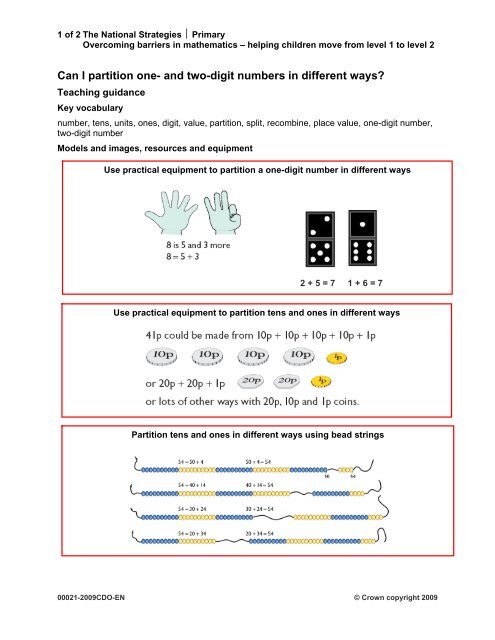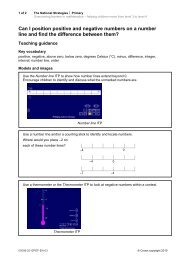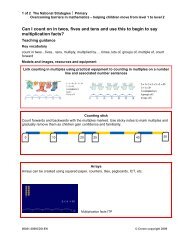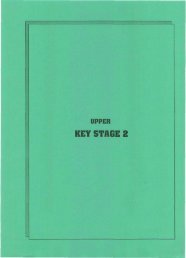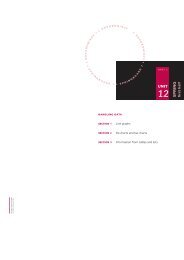Can I partition one- and two-digit numbers in different ways?
Can I partition one- and two-digit numbers in different ways?
Can I partition one- and two-digit numbers in different ways?
- No tags were found...
Create successful ePaper yourself
Turn your PDF publications into a flip-book with our unique Google optimized e-Paper software.
1 of 2 The National Strategies PrimaryOvercom<strong>in</strong>g barriers <strong>in</strong> mathematics – help<strong>in</strong>g children move from level 1 to level 2<strong>Can</strong> I <strong>partition</strong> <strong>one</strong>- <strong>and</strong> <strong>two</strong>-<strong>digit</strong> <strong>numbers</strong> <strong>in</strong> <strong>different</strong> <strong>ways</strong>?Teach<strong>in</strong>g guidanceKey vocabularynumber, tens, units, <strong>one</strong>s, <strong>digit</strong>, value, <strong>partition</strong>, split, recomb<strong>in</strong>e, place value, <strong>one</strong>-<strong>digit</strong> number,<strong>two</strong>-<strong>digit</strong> numberModels <strong>and</strong> images, resources <strong>and</strong> equipmentUse practical equipment to <strong>partition</strong> a <strong>one</strong>-<strong>digit</strong> number <strong>in</strong> <strong>different</strong> <strong>ways</strong>2 + 5 = 7 1 + 6 = 7Use practical equipment to <strong>partition</strong> tens <strong>and</strong> <strong>one</strong>s <strong>in</strong> <strong>different</strong> <strong>ways</strong>Partition tens <strong>and</strong> <strong>one</strong>s <strong>in</strong> <strong>different</strong> <strong>ways</strong> us<strong>in</strong>g bead str<strong>in</strong>gs00021-2009CDO-EN © Crown copyright 2009
2 of 2 The National Strategies PrimaryOvercom<strong>in</strong>g barriers <strong>in</strong> mathematics – help<strong>in</strong>g children move from level 1 to level 2Teach<strong>in</strong>g tips Provide children with practical experience of <strong>partition</strong><strong>in</strong>g a small number of objects <strong>in</strong>to<strong>two</strong> groups, for example by:o creat<strong>in</strong>g all the possible dom<strong>in</strong>oes with 7 spots;o putt<strong>in</strong>g out 8 biscuits onto 2 plates;o mak<strong>in</strong>g <strong>two</strong> jumps to l<strong>and</strong> on 9 on a number l<strong>in</strong>e. Model the <strong>different</strong> <strong>ways</strong> <strong>in</strong> which a <strong>partition</strong>ed number can be recorded, for example:8 = 5 + 3 8 = 3 + 5 5 + 3 = 8 3 + 5 = 8 Use equipment that helps children to ‘see’ that <strong>numbers</strong> can be <strong>partition</strong>ed <strong>in</strong> many<strong>different</strong> <strong>ways</strong>, for example:o Use a 100-bead str<strong>in</strong>g to <strong>partition</strong> number 46 <strong>in</strong>to tens <strong>and</strong> <strong>one</strong>s <strong>in</strong> <strong>different</strong><strong>ways</strong>. Model how these can be recorded as number sentences, for example:46 = 40 + 646= 30 + 1646 = 20 + 2646 = 10 + 36;o Use bundles of 10 straws <strong>and</strong> s<strong>in</strong>gle straws to help children see a <strong>numbers</strong>uch as 35 as:IIIIIIIIII IIIIIIIIII IIIIIIIIII I I I I I30 + 5IIIIIIIIII IIIIIIIIII IIIIIIIIII I I I I I20 +15<strong>and</strong> so on. Explore with children how to use <strong>partition</strong><strong>in</strong>g of a <strong>one</strong>-<strong>digit</strong> number <strong>and</strong> knowledge ofnumber facts to 10 to add <strong>and</strong> subtract <strong>numbers</strong> that cross the tens boundary. Askquestions such as:o What is 37 + 8? What number facts might you use to help you work this out? Howmany do you need to add to 37 to get to the next multiple of 10? How might you<strong>partition</strong> 8 to help you? How could you show that on a bead str<strong>in</strong>g or number l<strong>in</strong>e? Underst<strong>and</strong><strong>in</strong>g of <strong>partition</strong><strong>in</strong>g <strong>numbers</strong> <strong>in</strong> <strong>different</strong> <strong>ways</strong> (e.g. <strong>partition</strong><strong>in</strong>g 74 <strong>in</strong>to 70 + 4or 60 + 14) supports children’s underst<strong>and</strong><strong>in</strong>g of future calculation methods, for exampledecomposition<strong>and</strong> <strong>in</strong>formal methods of division us<strong>in</strong>g <strong>partition</strong><strong>in</strong>g.00021-2009CDO-EN © Crown copyright 2009


